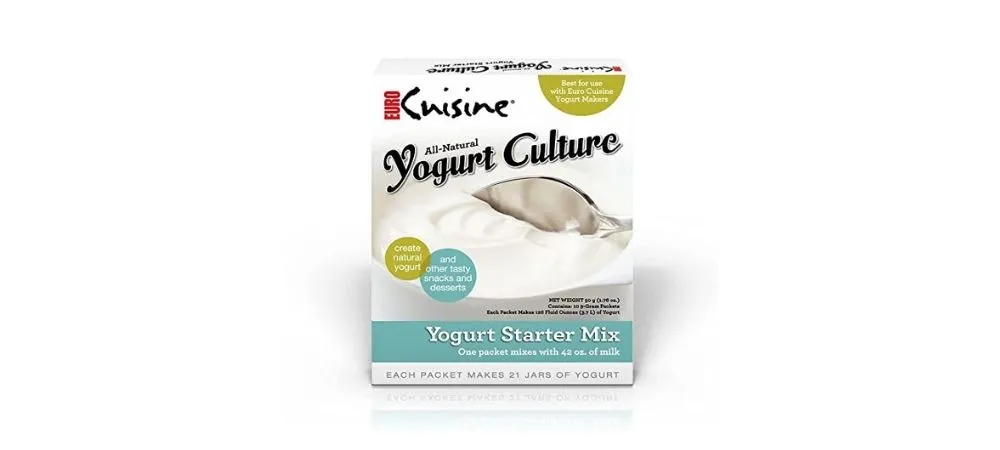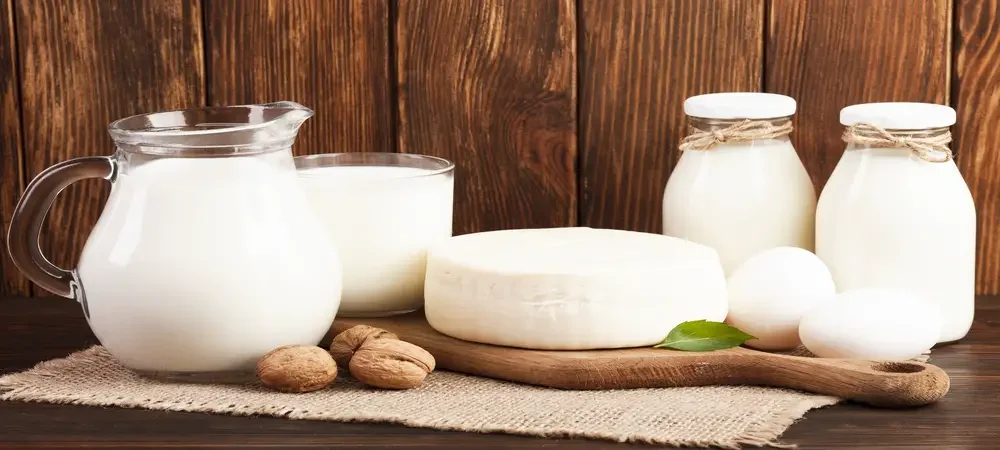Kefir and yogurt are similar because they are both cultured products in which lactic acid bacteria ferment milk and because they are both made with 2 types of starter cultures.
The main difference is that kefir is more watery and can be drunk, while yogurt thickens when it is cooled down and is generally eaten with the fruit, plain or with toppings like Granola.
Here is a quick nutritional comparison that gives you more insight on both these fermented products.
| Nutrition | One cup of plain, whole milk kefir | One cup of plain, whole milk yogurt |
| Calories | 161 | 138 |
| Protein (grams) | 9 | 7.8 |
| Fat (grams) | 9 | 7 |
| Sugar (grams) | 7 | 10.5 |
| Calcium (milligrams) | 300 | 275 |
Kefir vs. Yogurt
While Kefir is often known as drinkable yogurt but the two are entirely different. They are different dairy products but they are highly similar in uses.
Texture
Kefir resembles a milkshake in texture and yogurt is much firmer in texture. You can simply drink the kefir using a straw or from a glass. But you can eat yogurt using a spoon. Depending on the variety of yogurt, the texture varies. Say, Greek Yogurt is more firmer in texture than the regular yogurt.
Taste
While both are fermented products and hence contain a similar flavor in terms of sourness. However, kefir when over-fermentated may also resemble an alcoholic taste due to the higher production of ethanol by yeast. Store-bought yogurt is available in different varieties as Plain. Greek, Flavored, and frozen.
Process of Incubation
Both are made up of milk and covered under the fermented food category. However, the process of incubation is different. Kefir is based on mesophilic incubation i.e. left at room temperature to ferment. On the other hand, yogurt making is based on mesophilic process, where the incubation process require gradual warming.
The main component of yogurt is the probiotics that aid digestion while the main component of kefir is yeast. Due to yeast, the bacteria present in kefir yield ethanol that enlive the kefir batches with alcohol. Yeast is also used to create carbonated texture.
Milk Alternative for Preparation
While yogurt can be prepared only by fermenting the milk whether dairy or non-dairy, kefir can be made by substituting the water for milk. If you are sensitive to dairy, you may consider drinking kefir which is free from dairy. On the other hand, coconut yogurt and soy milk yogurt are prime examples of dairy-free yogurt.
Types of Bacteria
Yogurt contains 3 types of bacteria: Bifidus, lactobacillus bulgaricus, and streptococcus thermophilus. But Kefir grains are composed of microbial species such as lactic acid bacteria, fungi, acetic bacteria, and yeasts. But if you ferment kefir for a very short time, it does not produce much ethanol content.
Starter Culture for Fermentation
The starter culture used in making yogurt are either the dried cultures or the yogurt from the previous batch that are incubated to turn the milk into yogurt. For Kefir, Kefir grains are the combination of yeasts and lactic acid bacteria and thus ferment the milk during incubation. Once the kefir is ready, the kefir grains are simply removed.
Probiotic Level
Kefir contains more than three times probiotics than yogurt. While yogurt has only one to five cultures with six billion CFU, Kefir comes with 12 live and active cultures with 15-20 billion CFUs, according to healthline.
Some of the recommended Kefir that you should try:
- Lifeway Low Fat Kefir
- Maple Hill Creamery 100% Grass Fed Kefir
- 365 by Whole Foods Market
- Redwood Hill Farm Cultured Goat Milk Kefir
- Green Valley Creamery, Kefir
You can also try this Kefir Starter kit to easily prepare healthy kefir at home.
Important Note:
- Even though kefir contains bacteria able to destroy bad lactobacilli and yeasts, other contaminating microorganisms may still be harmful to health, especially if made from raw milk. Always make sure your kefir has a pleasantly sour taste, a pleasant aroma, and looks straightforward enough. Beware of thickening agents that can be mixed in it because these might be products with harmful additives.
- Fresh yogurt may also carry harmful bacteria, but if made with pasteurized milk or from a previous batch as a starter culture, the first batches usually don’t contain any dangerous bacteria.
- In conclusion, it can be said that kefir is slightly more beneficial than yogurt. Still, it also carries a higher risk of contamination, so careful supervision and good manufacturing practices should always be applied. They both go well as drinkable cultured products or in the form of thickened yogurts commonly known as Greek yogurt. Read, Benefits of Greek Yogurt to know more about Greek Yogurt!
Related Posts:
- Regular Yogurt Vs Greek Yogurt -Which is better
- Frozen Yogurt Vs Ice-cream – Which is healthy
- Yogurt Vs Curd – Are they different?
- Greek Yogurt Vs Turkish Yogurt – Which has high nutrition
- Grass-feed Whole Milk Yogurt Vs Coconut yogurt – Nutritional Facts!
- Yogurt Vs Milk – what should i choose?
- Sour Cream Vs Yogurt – Can i substitute yogurt for sour cream?
What is Kefir?

Kefir is a fermented beverage that originated in the Caucasus Mountains. It is prepared by inoculating cow, goat, or sheep milk with kefir grains — small white clumps containing bacteria and yeast that resemble cauliflower.
The fermentation process includes removing some of the sugars (lactose) from the milk, resulting in an easily digestible, slightly sour, and pleasantly effervescent beverage that has been claimed to be beneficial for a variety of ailments.
What are the Benefits of Kefir?
Kefir benefits, including those for digestive health, have been anecdotally reported by consumers and some small studies; however, no adequate clinical trials exist to support this claim. Kefir is available in any grocery store with a dairy department, and it is typically sold in a 16 oz plastic container. For comparison, the typical American consumes nearly 400 pounds of milk each year, and more than 65% of that is skim or reduced-fat.
Kefir is cultured from cow’s milk and has around 200 species of bacteria per milliliter, compared to less than 20 for yogurt. Kefir is said to contain even more beneficial bacteria than yogurt. These healthy lactobacilli bacteria found in kefir are part of your body’s natural digestive process, helping to keep your intestines healthy and working correctly.
Kefir is also made from fat-free or low-fat milk and whole-fat milk, giving it a higher calorie count than yogurt. A cup of low-fat kefir has around 150 calories (the same as whole milk), while non-fat versions have about 90 calories per serving.
What is Yogurt?

Yogurt, like kefir, is made from cow’s milk. Yogurt is a fermented dairy product that originated in the Middle East and Eastern Europe in 6000 BC. It has been claimed to have many health benefits, including improving lactose intolerance symptoms, strengthening the immune system, and reducing cholesterol levels.
There are hundreds of yogurts available today with various flavors, densities, and fat contents. Some types of yogurt contain added ingredients such as fruit or granola to increase the flavor experience and for added texture.
Yogurt is made by adding particular bacterial cultures (also known as “starter cultures”). The bacteria feed on the lactose in the milk (a natural sugar found in milk), converting it to lactic acid. The bacteria and the acid combination help preserve the yogurt, giving it a longer shelf life than fresh milk.
Yogurt made with low fat, or non-fat milk will have fewer calories than those made from whole or reduced-fat milk. A typical 6 oz cup of yogurt has around 150 calories (the same as whole milk), while fat-free types have less than 100 calories per serving.
What are the benefits of yogurt?
Yogurt benefits are much more significant, including but not limited to-
- Blood Sugar Regulation
- Improved Digestion by Helping Keep Intestinal Tract Healthy
- Boost and Strengthen Your Immune System to Fight Off Infections More Effectively
- Yogurt helps to break down carbohydrates into glucose, which the body uses as a source of energy.
- Lactose Intolerance – Most yogurts are made from “cultured milk,” or milk that has been fermented with bacterial cultures. The bacteria convert lactose (milk sugar) into lactic acid, making the yogurt easier to digest for lactose intolerant.
- Immunity – Yogurt has many live active cultures that help strengthen the body’s immune system by introducing healthy bacteria into the digestive tract.
- Prevention of Osteoporosis – Yogurts high calcium content helps prevent osteoporosis by strengthening bones, preventing bone loss, and decreasing the risk of osteoporosis.
- Some people who have trouble digesting lactose can still eat yogurt because it contains little to no lactose.
What is similar between Kefir and Yogurt?
Kefir and Yogurt are both cultured dairy products containing many beneficial bacteria, making them excellent options for lactose intolerant. As those with moderate to severe symptoms know, living an everyday life without dairy can be extremely difficult and limiting.
Kefir and yogurt are both properties that contain healthy bacteria that help keep the digestive tract healthy by introducing good bacteria into the intestines. They also help reduce cholesterol levels, fight infections more efficiently, and prevent osteoporosis.
What is different between Kefir and Yogurt?
Kefir has been said to have a tart, tangy taste that can be compared to drinking buttermilk or liquid yogurt. The grains in kefir help thicken the dairy product into a drinkable consistency. Some brands of kefir are even available in a sweetened vanilla flavor choice.
Both kefir and yogurt cultures can be found at your local grocery store, typically kept next to the other milk products as well as frozen dairy desserts like Frozen Yogurt. If you opt for yogurt with added fruit flavors or granola, it may contain more calories than plain, unflavored yogurt (typically lower in calories than flavored kefir).
Which One Should I Buy?
It isn’t easy to answer because it comes down to personal preference. Some people prefer the taste of yogurt, while others like the richness of kefir. Both products can vary significantly in taste and texture depending on the brand you buy.
In terms of nutrition, yogurt has a slightly lower calorie count than kefir, while they are both similar in fat content. Yogurt contains more calcium per serving, while kefir has slightly more protein-containing grams.
Clinical studies have also shown that yogurt and kefir are both excellent for increasing calcium levels. One study found that women who drank 3 cups of low-fat yogurt per day had increased their dietary intake of milk, calcium, phosphorus, magnesium, and zinc. Another study showed that women who drank 3 cups of kefir had increased their dietary intake of calcium by 564 milligrams per day.
There is no clear winner between them, as they have similar health benefits and nutritional value. Kefir tends to be slightly more beneficial for those with lactose intolerance due to its lower sugar content. Still, yogurt also has a more extensive array of flavors. Therefore, it can be more enjoyable to eat.
What’s the healthiest choice – Yogurt or Kefir?
While both kefir and yogurt are healthy choices, consumers should choose what they feel most comfortable with. Kefir is a traditional, dairy-based fermented beverage containing various beneficial bacteria and yeasts that may be more easily absorbed in the digestive tract than those from yogurt. On the other hand, Yogurt is made with added cultures to ferment milk and has fewer bacteria than kefir.
Although both products provide similar health benefits, including lactose tolerance for lactose intolerant and improved digestion for all, it’s up to the consumer to determine if kefir or yogurt is the best choice.
What kind of milk is used to make Yogurt and Kefir?
Both kefir and yogurt use cow’s milk which has a higher lactose content than goat’s or sheep’s milk, so those sensitive to dairy may find they have an easier time digesting yogurt.
Kefir and yogurt can use other types of milk, including soy, coconut, rice, and almond. But the bacterial cultures fermenting the milk will not be the same as those for cow’s milk. Hence, these alternative foods are not authentic kefir and yogurt.
Frequently Asked Questions
Why You Should Avoid Kefir?
Side effects such as bloating, nausea, constipation, and intestinal cramping are high with Kefir. Hence people with weak digestion should strictly avoid kefir. If you are allergic to milk then kefir may lead to some life-threatening reactions in your body
Is Kefir basically Yogurt?
No, although both of them are similar in application, Kefir and yogurt are different dairy products. Yogurt is made from cultured bacteria but kefir is made from kefir grains that ferment the milk.
Is Kefir A Spoiled Milk?
Kefir is fermented milk that has similar properties to fermented tea (Kombucha) or fermented cabbage.










